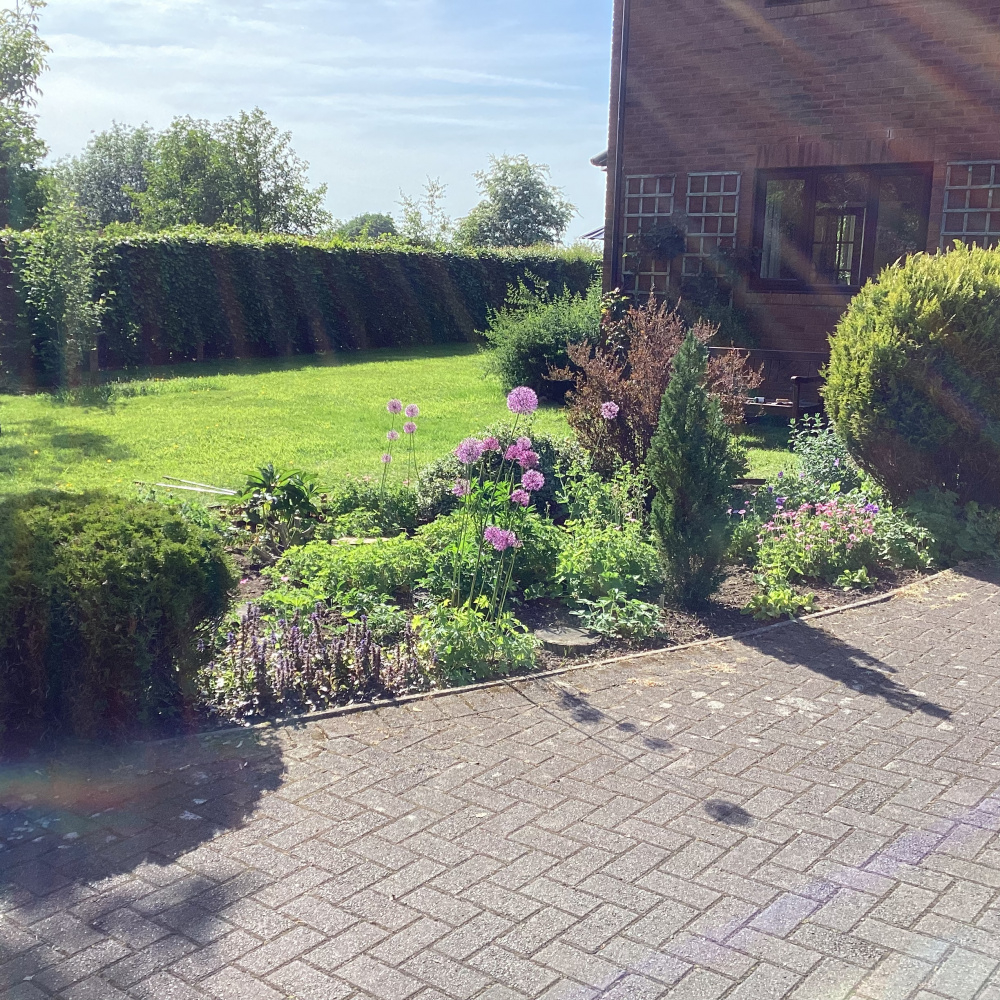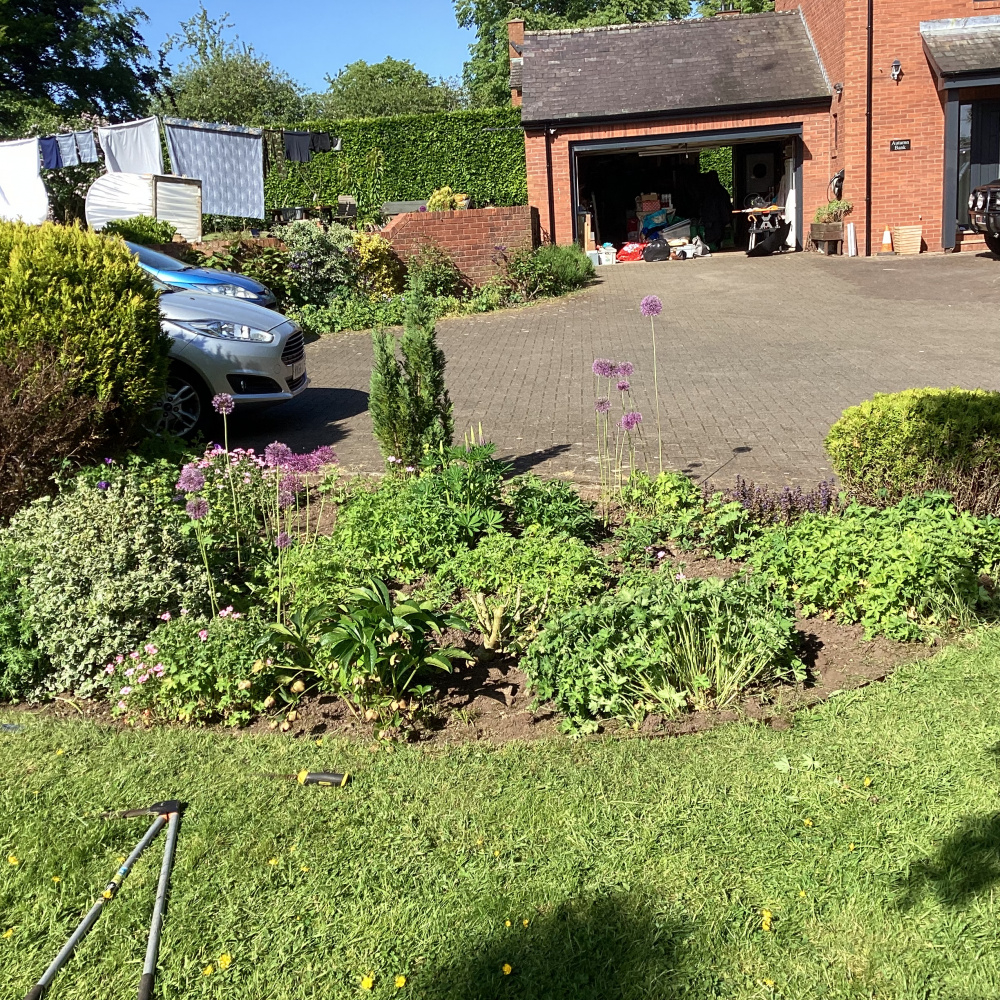This Forum will close on Wednesday 27 March, 2024. Please refer to the announcement on the Discussions page for further detail.
Ideas and advice for very small tree and dwarf shrub

 This island bed between my drive and lawn is not right design wise. I’ve never been happy with and think it needs layering up a bit. At the moment I have the following shrubs in it: Broomhill Gold, conifer Danica, Dward Physocarpus ‘Little Devil’, a small spiraea Anthony Waterer, Euonymous Emerald and Gold, an upright conifer and a Choisya- this has been hard pruned so doesn’t show on photos.
This island bed between my drive and lawn is not right design wise. I’ve never been happy with and think it needs layering up a bit. At the moment I have the following shrubs in it: Broomhill Gold, conifer Danica, Dward Physocarpus ‘Little Devil’, a small spiraea Anthony Waterer, Euonymous Emerald and Gold, an upright conifer and a Choisya- this has been hard pruned so doesn’t show on photos. I seem to quite good at colour scheming in the garden - the bed is mainly pinks and purples, but I’m hopeless at the ‘form’ aspect, and don’t have much confidence with that. I’m wondering if a a very small tree - about 5’, would help. Also I’d like another small shrub with purple leaves to balance the purple Physocarpus.
I’ve tried a Cotinus lilla but it didn’t survive -too dry I think. I’ve read somewhere about a thornless Berberis, so wondered if there is a dwarf, purple one?
Our soil is neutral I think, good soil loam/sandy and the bed is South facing and gets full Sun. The site is quite exposed to wind.
Any ideas for plants or design tools very much appreciated 😀
Our soil is neutral I think, good soil loam/sandy and the bed is South facing and gets full Sun. The site is quite exposed to wind.
Any ideas for plants or design tools very much appreciated 😀
0
Posts
The conifers, for example, will keep growing as long as they're happy, and all you need to do is trim lightly, so that you aren't cutting back into brown wood. Very few types can take that.
If you're concerned about the dryness of the site, it might be better to have fewer shrubs but let them grow properly to give height, and also use vertical perennials to give variety in that regard, along with the shrubbier specimens, and lower growing planting. Plenty of organic matter added will also help keep the soil healthy, and less likely to dry out rapidly. The more shrubs/trees you have, the drier it will become because they naturally take up more moisture. If you have consistently drier conditions, it's important to take that into consideration when choosing suitable plants of any kind
You've got alliums there, so you could add Irises, and things like Fennel, Liatris, Verbena bonariensis, Lychnis, Veronicas etc, to give those verticals. Bulbs in spring.
The purple Berberis aren't evergreen as far as I'm aware, unless there are newer varieties now. I don't know of any thornless ones though. There are plenty of purple leaved Hebes, and Pittosporums too, so they're worth considering, but there's not a lot of room for more shrubs or a tree there without removing something else.
I live in west central Scotland - not where that photo is...
Let the plants you have grow on a bit and take their shape. Gardening isn't instant like slapping wallpaper on a wall. It takes time for plants to mature to their full beauty.
Improving the soil would be good too so, after the next decent rainfall, give it a mulch of well-rotted manure and/or garden compost or bought in soil improver to provide nutrients and help retain moisture. Think also about adding some light and breezy looking verbena bonariensis in the gaps - picks up the colour scheme and adds height without bulk. For low growing ground cover and colour that erigeron would be perfect but a herbaceous salvia would give you some spikes of colour if that's the shape you're after.
I add low growing cosmos in lovely magenta pink colour each year, ready to go in now, but will add more lupins and research the other taller perennials you’ve suggested.
My garden is helping my well-being massively as I’ve had long covid for over a year, had to stop work, and have to pace myself strictly, but as long as I can potter a bit in the garden and keep learning I’m a happy woman😊
The conifer [B. Gold] won't stay terribly small. It gets to a couple of metres easily, and will have a decent spread too. Many conifers can take years to get to a certain height, but then they keep going, so you need to be sure what kind you have and how to maintain them. They're also a big draw on moisture, especially as they're shallow rooted, so if you're not in a wet part of the country, they can be a huge drain on resources, at the expense of other plants.
By your description, it sounds as though you're in one of the drier parts, so you'd need to look for planting that will suit, or be adaptable enough once established
I live in west central Scotland - not where that photo is...
Im sure with a few more tall perennials in it will look more balanced. Thankyou all for your advice, it’s much appreciated.
Your conditions will be quite similar to mine. I don't grow too many shrubs in the sunniest areas, I save most of those for the shady areas, but I pick ones which can cope with sun if I use them. It just comes down to the right plants for the site.
Euphorbias are very useful for all sorts of aspects too, so they'd be fine with the aforementioned Hebes if you want some structural planting for all year round colour, but it's about mixing different types of planting to give a good balance. Another useful upright plant is Achillea, and the shrubbier planting will also save a lot of plant supports as they do the job for you
I live in west central Scotland - not where that photo is...
My current back garden [also south-ish facing] was windy and exposed, because it had never really been cultivated, so the first thing I did was create a new boundary fence and a good shelter belt. That's vital if you then want to create a bit of a micro climate in order to grow certain plants. Even fairly bog standard ones can struggle if they don't have enough protection from different types of weather. Then it's about the soil, and it's structure.
Those two things are what dictate the type of plants that will cope, as well as ongoing conditions, especially the temps.
Euphorbias are only a problem when you cut them back, and it's just a question of doing it from the back of the plant to the front, so that you aren't leaning over a cut stem, and wearing gloves. I usually give the secateurs a wash/clean afterwards. I don't wear gloves very often either - only for heavier jobs.
I live in west central Scotland - not where that photo is...